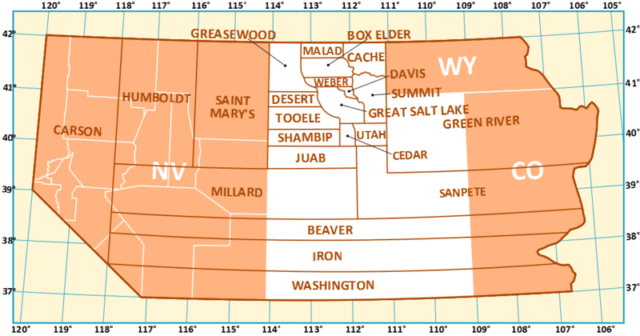At one point The Cedar Valley, which currently is home to Eagle Mountain, Cedar Fort, and Fairfield was a county by itself. “In one of several efforts to reduce the size of Utah county, Cedar Fort was designated as the county seat of Cedar County, which existed between 1856 and 1861, at which point it was reincorporated into Utah county. In 1858, when Johnston’s Army arrived in Utah, it initially encamped at Cedar Fort, later moving near Fairfield to establish Camp Floyd.*“
The small town of Cedar Fort, that is nestled in the Cedar Valley just west of Eagle Mountain was once the county seat for the short lived Cedar County in Utah, then the territory of Utah, for 5 years. The county was created on Jan 5th, 1856 and was dissolved on Jan 17th, 1862.
Creation of Cedar County

During the 5th Session of the Utah Territorial Legislature Cedar County became a legal entity. “All that portion of Utah Territory bounded north by Great Salt Lake county, east by a line running lengthwise through the center of Utah Lake and by the center of the channels of Jordan river and Salt Creek, so far as those streams run in Utah county; south by Juab county and west by Tooele county, is, and shall hereafter be called Cedar County, and the probate judge, when elected, is hereby authorized to organize the same and locate the county seat thereof.”

Utah Historical Quarterly had this to say about Cedar County. “Cedar County was created from that part of Utah County which approximates present-day Cedar Valley.”
Cedar County Court
Cedar County had its own Court System. “The Cedar County Court was established with the creation of the county by the territorial legislature in January 1856 (“An Act in Relation to Counties,” Laws of Utah, 5th Annual Session, 1855-1856, sec. 8, p. 7 ). The Court was authorized to manage all county business and county property. The County Court was abolished with the dissolution of the county in 1862.*“
Some of the functions of the Cedar County Court included
- The Court was to manage all county business and county property, “and generally do, and perform, all such duties, as shall be required by the nature of their office, and as shall be required by law.”
- The Court was to audit and settle all claims against the county, and to audit and settle accounts of any collector of county revenue, taxes, or income payable into the county treasury.
- The County Court set polling places, appointed election judges, and oversaw the conduct of elections.
- The County Court oversaw the layout of roads.
- The Court could regulate bounties on wolf and fox pates.
- It was in charge of fisheries to prevent the needless destruction of fish.
It should be noted here, that first probate Judge of Cedar Valley (1857-1859) was Allen Weeks, who was also the bishop and one of the first settlers of Cedar Fort. He was later followed by Zerubbabel Snow as Judge (1859-1862). Most of the documents for Zerubbabel Snow are signed Z Snow. The court also used Selectmen as well as the probate judge. “The first three Selectmen were chosen by the Probate Judge until a county election could be held, after which Selectmen were elected for staggered three year terms. After that, vacancies were to be filled by the County Court if a majority remained, otherwise a special election was required. Between meetings of the Court, the Selectmen could transact business separately throughout the county relating to the poor, insane, orphans, minors, or other important business requiring immediate attention. They were required to report that business at the next session and have it approved by the Court before it became a matter of record. Selectmen and the Probate Judge were all required to take oaths and file bonds. *“
Dissolution of Cedar County
Cedar County was dissolved by failure to include the law creating the county in a list of revised laws (“An Act in relation to the Compilation and Revision of the Laws and Resolutions in force in Utah Territory, and embodying certain Amendments,” Laws of Utah, 11th Annual Session, 1861-1862, p. 14-32 ) and by dividing the territory once included in Cedar County between Tooele and Utah Counties (“An Act Defining the Boundaries of Counties, and for other Purposes,” ibid., p. 46-51. ).*
Mike Kieffer – Editor-in-Chief, Cedar Valley Sentinel
Mike Kieffer is a dynamic leader and community advocate based in Eagle Mountain, Utah. He serves as the Editor-in-Chief of the Cedar Valley Sentinel, a local publication dedicated to informing, inspiring, and elevating the Cedar Valley community through honest and accurate journalism. With a passion for fostering connections, Kieffer has made it his mission to highlight local businesses, provide reliable news, and support community development.
Beyond his editorial role, Kieffer is the owner of Lake Mountain Media, LLC, a company specializing in media and communications, and the co-owner of Quail Run Farms, which focuses on sustainable farming and community engagement. He also actively contributes to the local economy and culture as a member of the Eagle Mountain Chamber of Commerce.
Kieffer’s dedication extends to preserving and promoting the history and heritage of the Cedar Valley area. He often participates in community-centered events and media, including podcasts that explore the unique aspects of life in the region. Through his varied endeavors, he remains a steadfast advocate for the growth and enrichment of the local community.
